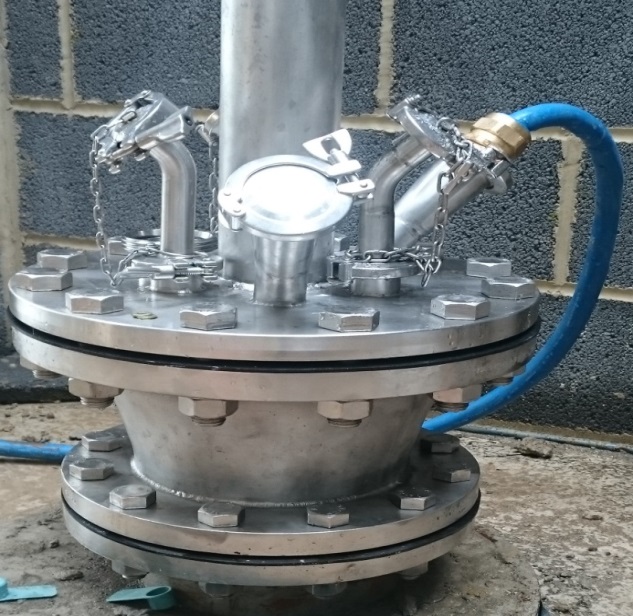
Drilcorp was recently contacted by a major construction company that had discovered a potential problem on one of their projects in London. During excavation work to reduce the ground level for the creation of a new basement at the development, the construction company had discovered a steel casing protruding from the ground right at the centre of operations.
Subsequent investigation identified it as an old disused water supply borehole that had been drilled into the upper greensand over 300 metres below ground. The borehole had been abandoned and buried by the previous landowners and the headworks had been permanently sealed. During the recent excavation on site, the top of the casing had been slightly damaged and water was found to be seeping from it.
Drilcorp had recently worked on a nearby site and knew that the Upper Greensand aquifer in the region had an artesian head of around 15 metres above ground level. This meant that, if cut open, the borehole could potentially flow at 60 – 80lt/second, which would cause significant problems at the development. There was no further information on the borehole and it was not known what would be discovered if the casing was cut open. The site and surrounding area could be seriously flooded if any rash decisions were taken.
As a result, the borehole had to be removed to enable work to continue on-site and so the construction company engaged with Drilcorp to carry out immediate remedial action.
Drilcorp’s preliminary approach was to send an engineering crew to carry out some cautious intrusive investigation. Several ½” holes were drilled into the top of the 10” casing and threads were quickly tapped before fitting ½” ball valve valves. A pressure gauge was also fitted to one of the valves and it was found that water inside the casing was at a pressure of 1.4bar. This meant that water would rise to 14 metres above the level of the casing if allowed to flow. Next, a small endoscope was fed into one of the other holes and lowered to 5 metres below ground level. This showed that there were no other obstructions within the 10” casing.
The other unknown piece of information required by the Drilcorp team was, ‘How many casings were there?’ The headworks were a mixture of flanges, which indicated that several different casings may be present when it came to cut into the borehole.
With all available information to hand, a factual report on findings was prepared for the client on how to progress with the abandonment of the borehole in a safe and controlled manner.
Following Drilcorp’s risk assessment it was decided to proceed with the abandonment of the borehole. Due to the construction work taking place on this site, it was not feasible for the borehole casing to be left in its current location. It was blocking key construction areas and so the client determined that it should be terminated expertly and quickly, so as not to flood the whole area.
It was agreed that works were to be carried out over a weekend when there would be only minimal activity on-site. Drilcorp procured a heavy-duty borehole packer constructed with no flow through ports. Drilcorp’s heavy-duty Fraste FS300 drilling rig was also mobilised to the site and set up over the borehole. A large lagoon was excavated adjacent to the borehole to capture released artesian groundwater once the casing was cut.
The next step was to set up two 8” centrifugal pumps from the lagoon in order to carry water to nearby storm drains. A wire sawing machine was then set up in the position to cut horizontally through the casing. The upper section of the casing above the cut was held in tension with the drill head while cutting was taking place.
The cut was carried out and water immediately began to flow from the borehole at 10lt/sec. Although this flow rate was much lower than the potential 80lt/sec anticipated, it would still have been sufficient to flood the area quickly without the careful precautions taken by the Drilcorp team.
The borehole, which was known to be more than 300 metres deep, was tagged to 55mbgl and found to be open to this depth. A sealed inflatable packer was then run into a depth of 50mbgl on drill rods and then inflated. This resulted in the gradual slow in flow of groundwater until finally, the flow stopped completely.
With the water contained, a tremie pipe could then be run into the casing to the top of the packer and quick-setting cement pumped through the pipe. The drill rods were then removed leaving the packer in place, sealed from above with cement. The following day, the team topped up the entire casing with cement and, once it had set, the casing was excavated by the client.
Finally, Drilcorp cut the casing off below the operational site level. A steel blind flange was welded to the top of the casing to ensure that the borehole was permanently isolated and that the client could now continue construction work with confidence.
The operation on this London site was 100% successful. It should be noted, however, that it had to be planned with meticulous detail before any actions were taken. Serious disruption and costly uncontrollable site flooding could easily have occurred without thorough inspection and preparation.
To find out more about artesian control services provided by Drilcorp, please get in touch via info@drilcorp.com or by calling 0191 5273970.